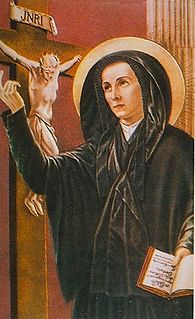Ceraunus (Céran) was bishop of Paris. His relics are in the church of St. Genevieve, Paris; they are on the altar of St Clotilda. He is also said to have been bishop 609 to 622.
Aspasius of Auch was a Christian leader of the 6th century canonized as a saint.

Saint Galation or Galaction was supposedly a martyr with his wife, Episteme, whom he converted. The story is that he was the son of Saints Clitaphon and Leucippe, and that he became a hermit, while Episteme joined a community of virgins. Both went away to the mountain of Publion, Galaction to a men's monastery and Episteme to a women's. They did not leave their monasteries, and neither saw the other until the time of their death. A fierce persecution arose, and they were both brought to trial. When Galation was martyred under Decius at Emesa on 251 AD, Episteme went to his side and died with him. His feast day is November 5.
Saint John IV, called the Peacemaker and known in Italian as Giovanni d'Acquarola or Giovanni Scriba, was the Bishop of Naples from an unknown date until his death. He is one of the patron saints of Naples and his feast day is 22 June. He had the relics of Aspren translated to the church of Santa Restituta in Naples. He also assisted Duke Andrew II in negotiating the Pactum Sicardi, an economic treaty, with Sicard, Prince of Benevento.
Saint Ava is a Roman Catholic saint. Ava was the daughter of Pepin. She was cured of blindness by St. Rainfredis. She then became a Benedictine nun at Dinart, Hainaut, located today in Belgium, and was elected abbess c. 845.
Juan de Ortega, better known as Saint John the Hermit, was a Spanish priest and hermit. A disciple of Dominic de la Calzada, he is best known for repairing roads and bridges along the Camino de Santiago. He also built a hospice as a shelter for pilgrims and founded the monastery of San Juan de Ortega.
Elias of Jerusalem was a bishop and Patriarch of Jerusalem from 494 until he was deposed by Byzantine Emperor Anastasius I in 516 for supporting the decrees of the Council of Chalcedon. At the Synod of Sidon (512) he successfully defended, together with Flavian II of Antioch, the dyophysite Christological doctrine proclaimed by the Council of Chalcedon.
Leontius of Caesarea was a bishop of Caesarea Mazaca, in Cappadocia. He was childhood friends with Gregory the Illuminator, later in life Leontius would consecrate Gregory to become the patriarch of the Armenians. Leontius attended the First Council of Nicaea in 325.
Sidonius was an Irish-born French monk and saint. He was the spiritual teacher of Leutfridus. He is venerated in the Roman Catholic Church and Eastern Orthodox Church.

Saint Aquilinus of Milan, also known as Aquilinus of Cologne, is venerated as a martyr by the Catholic Church.
Saint Aquilinus was a Frankish bishop and hermit. Born in Bayeux, he had been a warrior in the service of Clovis II and married in 660 at Chartres. He moved to Évreux with his wife, and both cared for the poor and sick in this town. In 670, he was named bishop of the city, but Aquilinus preferred to live as a hermit. His feast day is 19 October.
Rictrude was abbess of Marchiennes Abbey, in Flanders. The main early source for her life is the Vita Rictrudis of Hucbald, commissioned by the abbey, and written in 907 by Hucbald.

Lucy Filippini is venerated as a Roman Catholic saint.
Flavius Latinus was a Christian martyr of the persecutions of Trajan.
Saints Felix and Constanza were a brother and sister from the Roman city of Nuceria Alfaterna, and were martyred by the emperor Nero in 68 AD.

Felicitas of Padua is a saint in the Roman Catholic Church. She lived in the ninth century, and was a nun in Padua, probably at the convent of Saints Cosmas and Damian. Her relics are now in the Basilica of Saint Justina, Padua.
Saint Sixtus of Reims is considered the first bishop of Reims. According to Hincmar, a 9th-century archbishop of Reims, Sixtus was sent from Rome by Pope Sixtus II to Gaul to assist in Christianizing the region. Another tradition makes him, anachronistically, the disciple of Saint Peter.
According to tradition, Sixtus of Reims, along with his companion St. Sinicius (Sinice), established the Christian sees of Reims and Soissons. Sinicius would later succeed Sixtus as bishop of Reims. According to one source, “it would appear that Sixtus did not die as a martyr, despite the severity of the persecution during the era.”
Matthew Bunson is an American author of more than fifty books, a historian, professor, editor, Roman Catholic theologian, Senior Contributor for EWTN, the Catholic multimedia network, Senior Fellow at the St. Paul Center for Biblical Theology, and Faculty Chair at Catholic Distance University.
Januarius and Pelagia were joint Christian martyrs and saints recorded in the Jerusalem Martyrology. They were beheaded or racked and torn with iron claws and pieces of earthware at Nicopolis in Armenia during the reign of the Roman emperor Licinius. Their feast day observed on July 11.
They are possibly to be considered identical with SS Januarius and Marinus who were martyred in the same place in the same year under identical circumstances with the martyrs Nabor and Felix; their feast day, however, was observed on July 10. Alternatively, the quartet may have been a combination of Januarius and Pelagia with the SS Nabor and Felix were martyred in Italy in the early 4th century.
Saint Martin of Arades, also called Martin of Corbie, was a canonized monk from Corbie Abbey, whose feast day is November 26 in both the Roman Catholic and the Eastern Orthodox Church.






